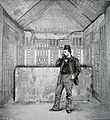Palace facade

In Egyptology, a palace facade in the narrower sense is a facade richly structured with niches . Palace facades have been attested since the 1st dynasty (approx. 3000 BC) and experience their heyday during this time. They appear as an important style element on the outside of the mastabas of this time.
Symbolic use
With the royal Horus name in hieroglyphic writing , the Horus falcon sits on the highly stylized and scaled-down representation of a building with a palace facade, the so-called Serech . It is therefore usually assumed that this type of niche structure goes back to the structure of the facade of a palace. Remnants of such a palace were possibly found in Hierakonpolis .
The motif of the niche-structured facade may have been adopted in Egypt from Mesopotamia . Palace facades can also be found as a motif on coffins and sarcophagi and are documented until Roman times.
Examples of palace facade patterns
Enclosing wall of the Djoser pyramid
complex in palace facade architecture (3rd dynasty)Mykerinos sarcophagus with patterned palace facade (4th dynasty)
Burial chamber of the Unas pyramid with palace facade pattern (5th dynasty)
literature
- Dieter Arnold , in Temples of Ancient Egypt (edited by Byron E. Shafer), Cairo 2005, ISBN 1850439451 , pp. 32-33.



